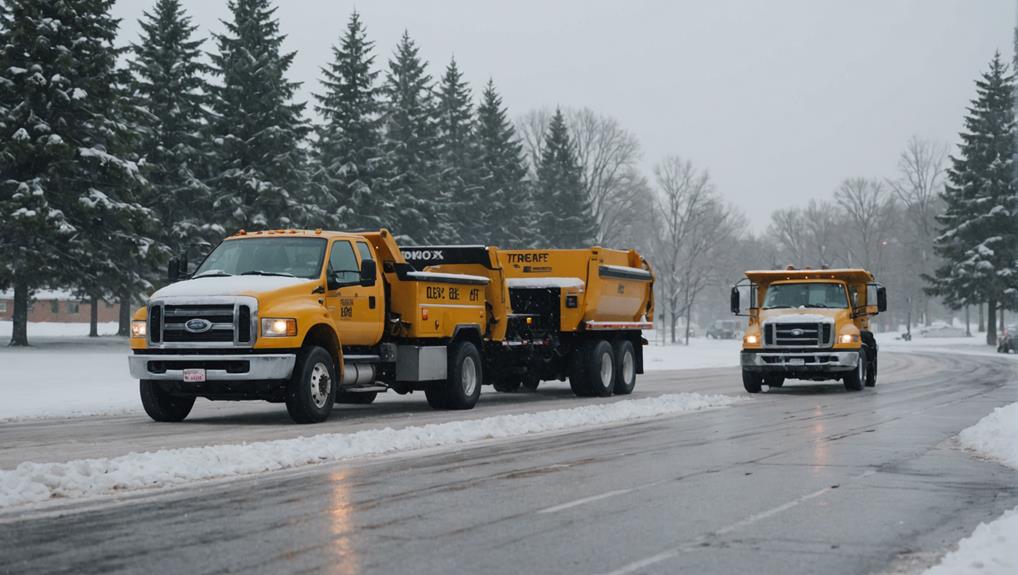
Table Of Contents
Heated Driveway Systems
Heated driveway systems are designed to melt snow and ice as they accumulate on surfaces. These systems utilize electric cables or hydronic tubes installed beneath the surface. When activated, they generate heat that raises the temperature of the driveway, preventing snow from bonding to it. This technology reduces the need for manual snow hauling, as snow can simply melt away without requiring extensive shoveling or plowing.
The effectiveness of heated driveway systems largely depends on the climate and the installation's quality. In regions with heavy snowfall, these systems can be invaluable. They help avoid the physical strain associated with traditional snow removal methods. Additionally, heated systems can extend the life of the driveway by preventing damage caused by freeze-thaw cycles. Overall, they provide a convenient solution for snow and ice management.
How They Work and Their Effectiveness
Heated driveway systems utilize electrical or hydronic heating elements embedded beneath the surface to melt snow and ice. When activated, these systems efficiently prevent the accumulation of snow, providing homeowners with a clear and safe surface for walking and driving. The consistent warmth generated by these systems works effectively in various weather conditions, reducing the need for physical snow hauling.
The effectiveness of heated driveways can be measured by their ability to maintain a clear pathway even during heavy snowfall. This technology minimizes the risks associated with icy surfaces, providing peace of mind for residents. While the initial installation might require a significant investment, the long-term benefits often outweigh the costs, particularly in regions with frequent snowfall where snow hauling becomes less of a burden.
Ice Melt Products
Ice melt products play a crucial role in enhancing safety during snowy conditions. These products come in various formulations, including chemical and natural options. Chemical ice melts often contain compounds like calcium chloride or magnesium chloride, which effectively lower the freezing point of ice, allowing it to melt more quickly. Natural alternatives, derived from substances like beet juice or rock salt, can also be effective but typically require more frequent application and may be less effective in extremely low temperatures.
When considering snow hauling services, utilizing ice melt products can significantly improve efficiency. Applying these substances before or during snowfall can reduce the accumulation of ice, making it easier to clear driveways and walkways. Homeowners should evaluate the specific needs of their property, such as the type of pavement or the surrounding environment, as this will influence the choice between chemical and natural ice melts.
Comparing Chemical and Natural Ice Melting Solutions
Chemical ice melting solutions, commonly composed of substances like calcium chloride or magnesium chloride, offer rapid melting capabilities. These products effectively lower the freezing point of water, making them ideal for combating icy surfaces quickly. However, they can sometimes pose risks to the environment, especially if excess runoff occurs. Salt-based deicers are often detrimental to surrounding vegetation and can corrode concrete or metal surfaces over time. For homeowners concerned about these drawbacks, exploring natural alternatives may provide a more sustainable option.
Natural ice melting solutions typically include beet juice, vinegar, or even sand. These products are friendlier to the environment and plants, minimizing damage while still assisting in snow hauling efforts. Although natural methods may not melt ice as quickly as their chemical counterparts, they can be effective with proper application. Combining multiple approaches can offer a balanced strategy, utilizing chemical solutions for urgent situations and natural products when environmental impact is a concern. This dual approach enables effective snow management without compromising ecological values.
Budgeting for Snow Removal Equipment
Investing in snow removal equipment often involves a careful assessment of both immediate needs and long-term costs. Basic tools such as shovels and snow brushes are relatively inexpensive, while larger machines like snow blowers can require a more significant investment. When considering options, it is essential to factor in not only the purchase price but also maintenance and storage considerations. For those with extensive driveways or larger properties, snow hauling services may also be a consideration, especially during particularly heavy snowfall periods.
Budgeting should also account for seasonal expenses related to snow removal. While initial costs may seem manageable, ongoing products like ice melt and the upkeep of equipment can add up over time. Homeowners should evaluate their specific conditions, including driveway size and typical winter weather, to determine if a hefty investment in more advanced equipment or services is worth the long-term financial commitment. Snow hauling can be a convenient solution for those looking to minimize their workload during heavy snow events.
Cost Estimates for Different Types of Tools
When considering snow removal equipment, costs can vary significantly based on the type of tools or systems selected. For basic tools, such as shovels or standard snow blowers, prices can range from $20 for hand shovels to upwards of $600 for a mid-range snow blower. These tools provide initial affordability but may require more physical labor. For larger properties or regions with heavy snowfall, more advanced equipment like heated driveway systems may be a costlier investment. Installation for these systems can reach several thousands of dollars, making them a long-term solution that often pays off in reduced labor and time spent on snow hauling.
Budgeting for ice melt products also involves distinguishing between chemical and natural solutions. Chemical options, while effective, may cost between $15 to $30 for a 50-pound bag, depending on the specific formulation. Natural alternatives tend to be priced higher but are gaining popularity for their eco-friendliness. Homeowners need to calculate potential costs not just for the product itself but also for the frequency of use, especially in regions that require regular snow hauling during winter months. As prices fluctuate, it’s essential to plan accordingly to ensure that the chosen method remains both effective and within budget.
FAQS
What are heated driveway systems?
Heated driveway systems are installations that use electric cables or hydronic tubing to melt snow and ice on driveways, providing a clear surface without the need for manual shoveling.
How effective are heated driveway systems?
Heated driveway systems are generally very effective, especially in preventing snow accumulation and providing safer driving conditions. Their effectiveness can vary based on the system type and local climate conditions.
What are ice melt products, and how do they work?
Ice melt products are substances used to lower the freezing point of water, thus melting ice and snow. They can be chemical-based, like salt, or natural alternatives that are more environmentally friendly.
What is the difference between chemical and natural ice melting solutions?
Chemical ice melting solutions often work more quickly but can be harmful to plants and pets, while natural alternatives are generally safer for the environment but may take longer to be effective.
How should I budget for snow removal equipment?
When budgeting for snow removal equipment, consider the type of tools you need (e.g., shovels, snow blowers, heated systems), their costs, maintenance, and any additional supplies like ice melt products. Cost estimates can vary widely based on quality and brand.




